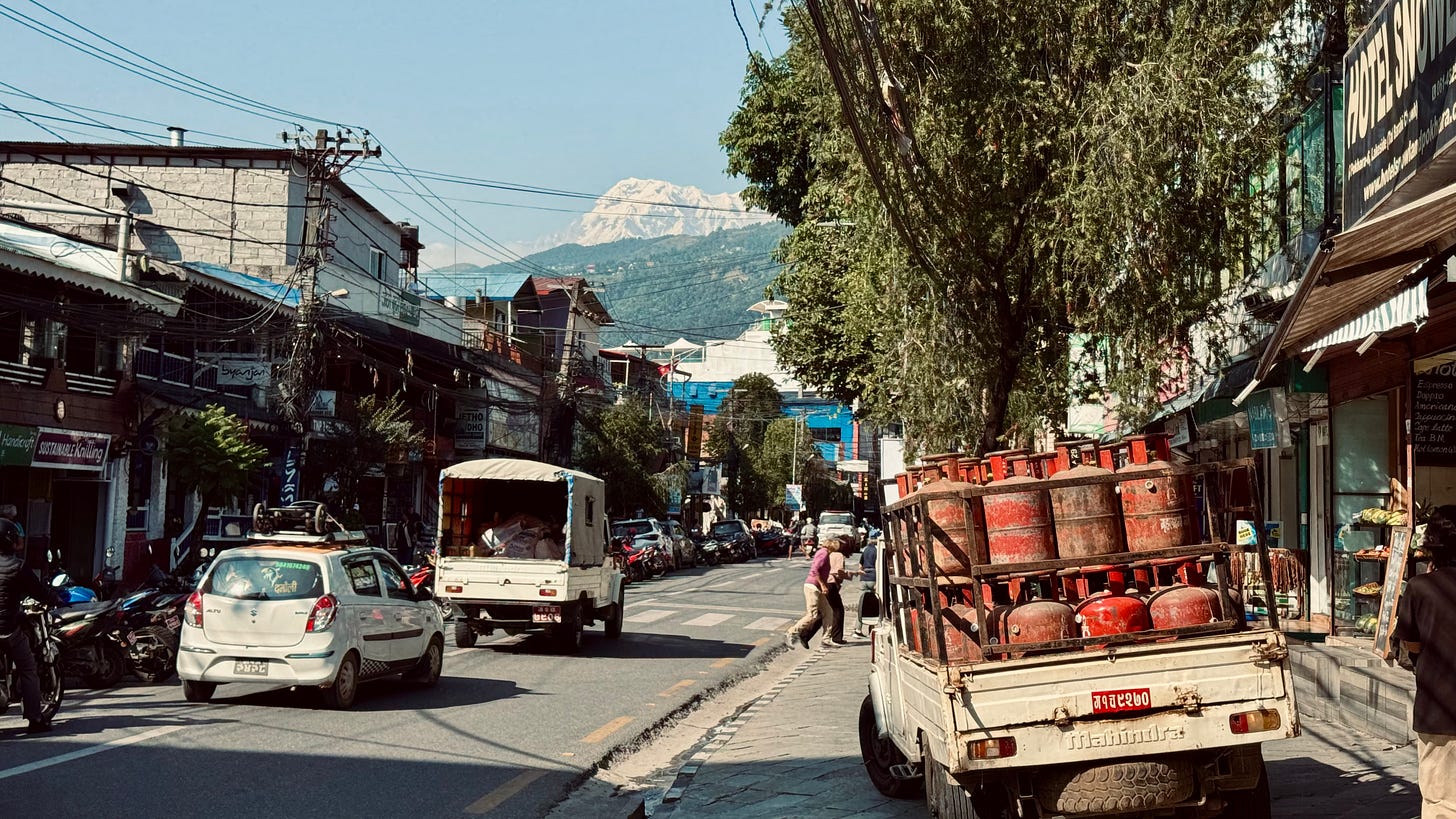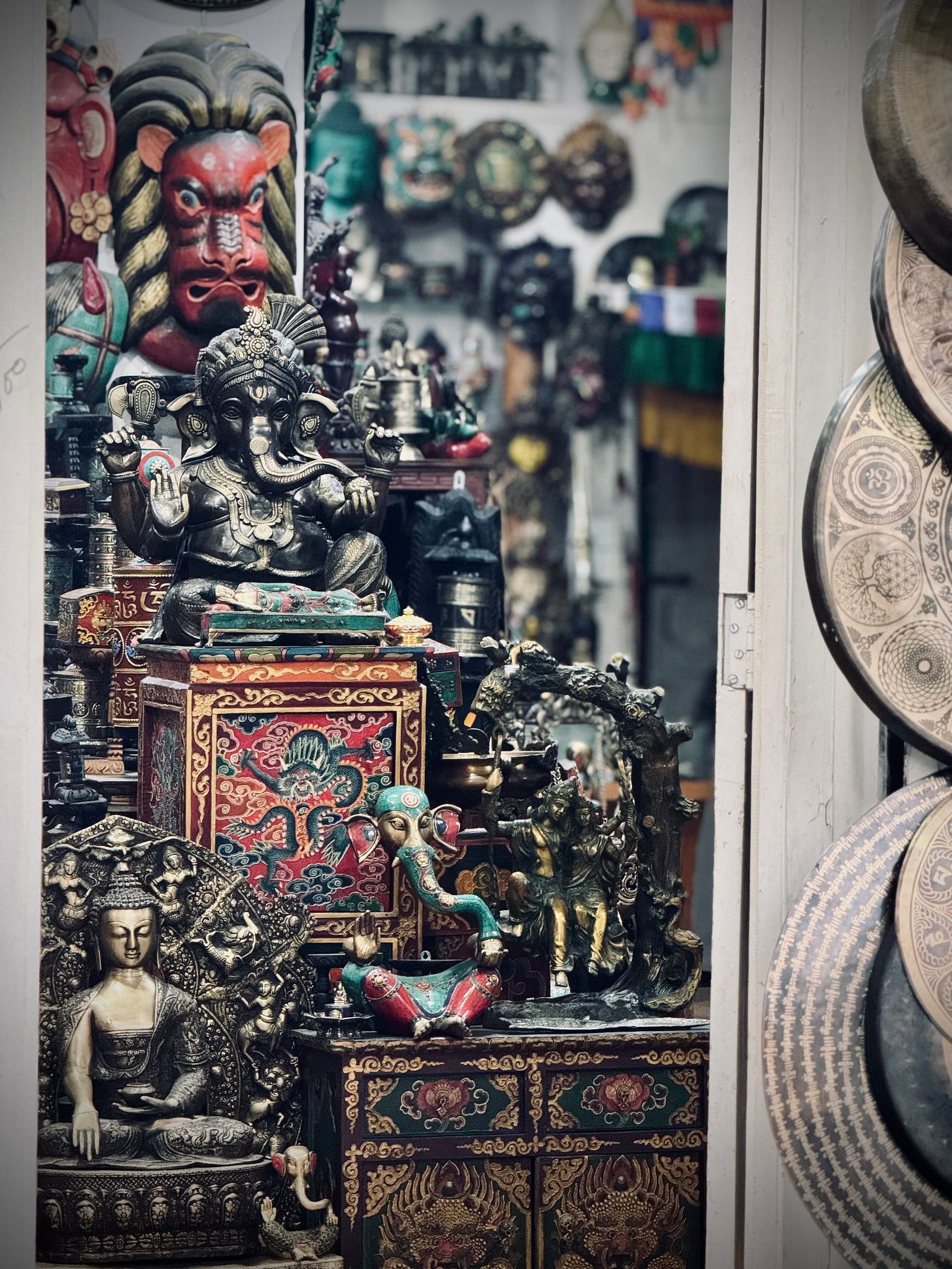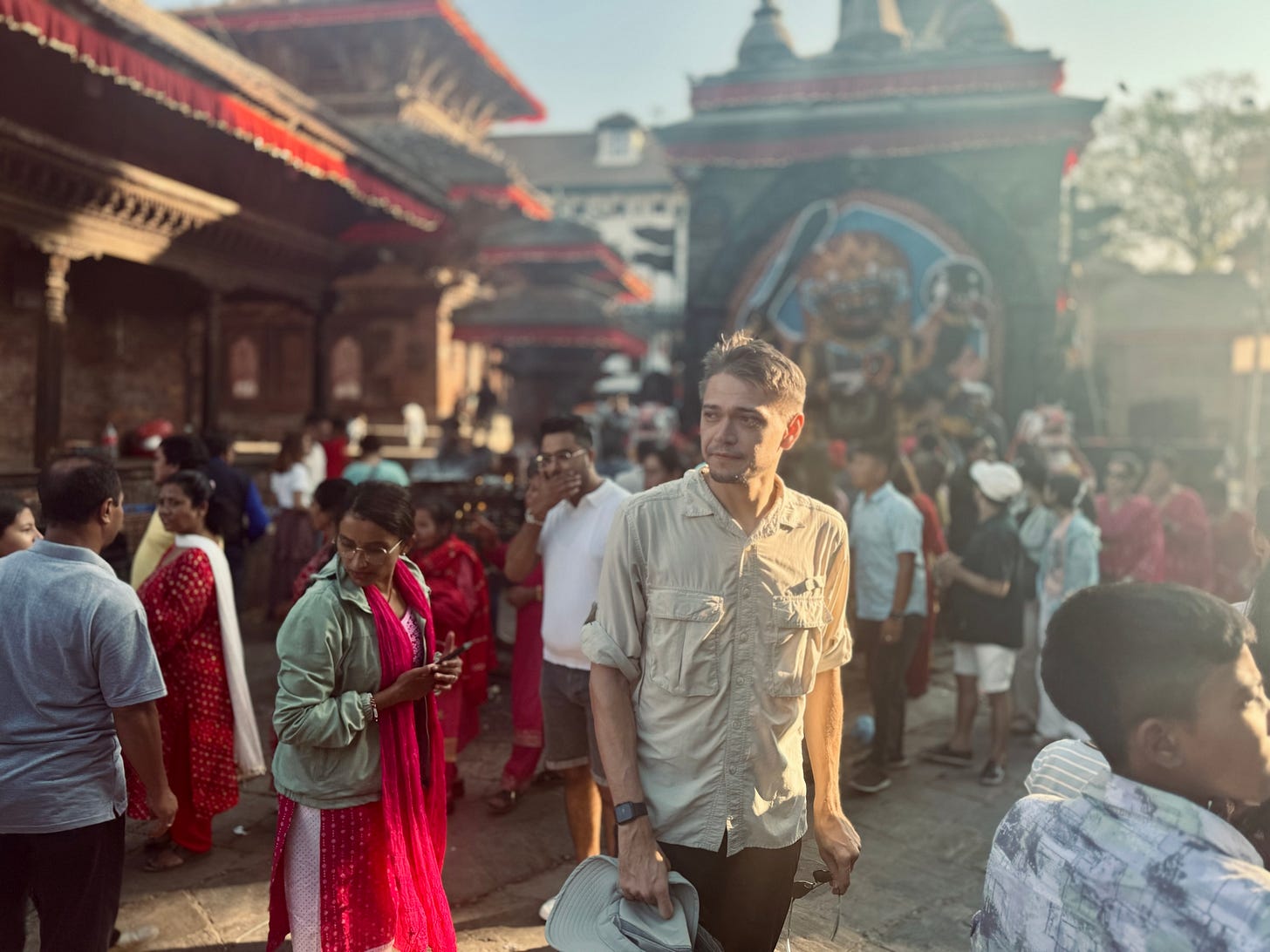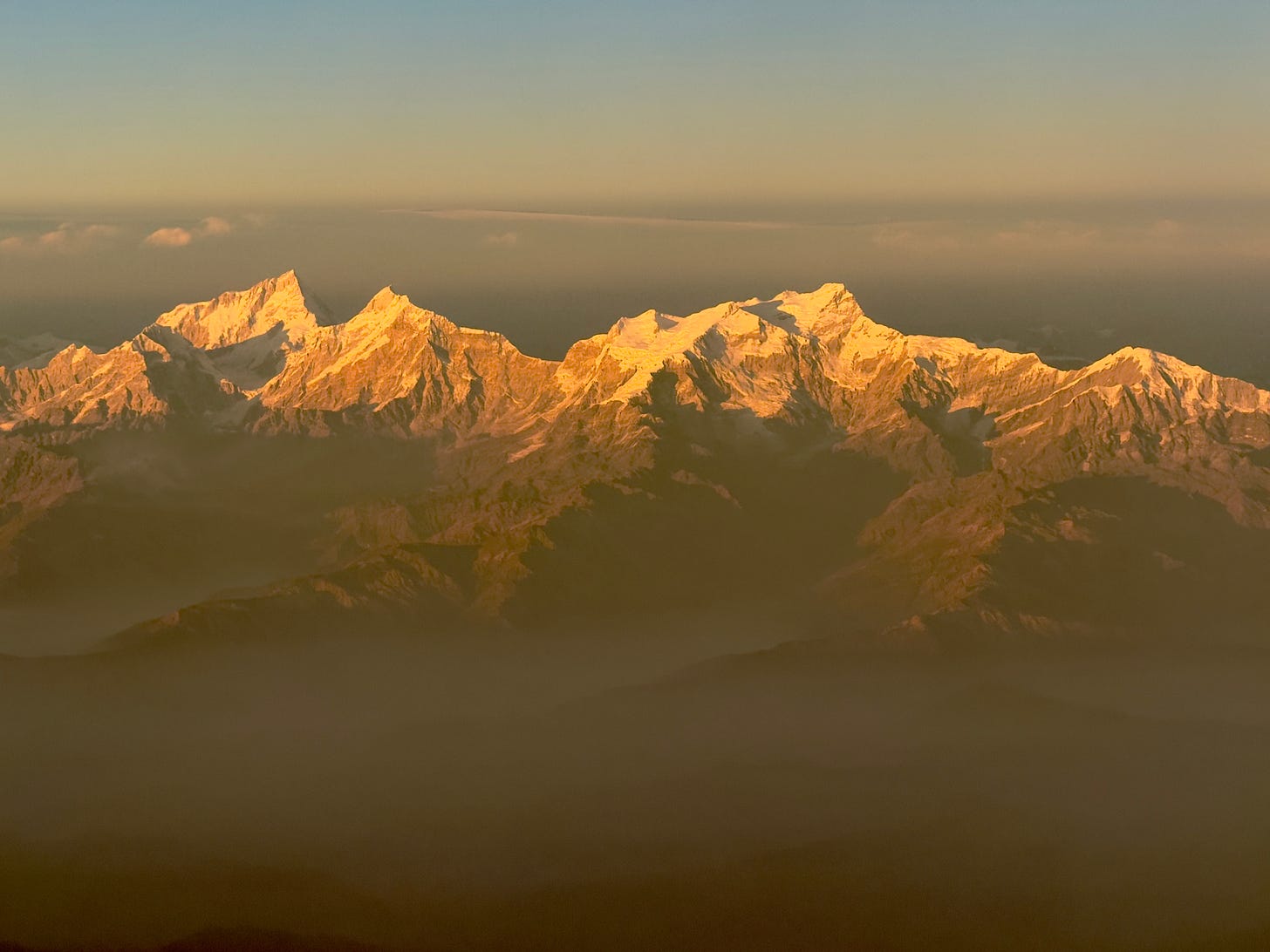The (cursed?) journal I found in Nepal
HOUSE OF SNOW: PART I - When a stranger’s story knows things you’ve never said out loud, decades before they happened.
Although I grew up in a missionary family in post-colonial Africa, I do not consider myself particularly spiritual. But this past year has challenged my beliefs. I’ve experienced things I struggle to explain... Events and phenomena that do not fit neatly within the “rational” framework I traditionally rely on to make sense of the world.
Which is why I invite you to make sense of them with me.
Perhaps, between us, we can contextualize the magic as simply “science we don’t understand yet” - beginning, naturally, with the mid-20th century journal I discovered in a dusty antique store while in Pokhara, Nepal.
I’ll do my best to follow the thread of that day in early December.
A world out of time
Winter had come.
Trucks trundled by, heavy with fuel tanks headed for far-flung teahouses, where they’d feed fires for cooking and warmth. People scurried past in knitted hats, yak wool scarves, and knock-off North Face jackets. I was woefully underdressed and eager to get back before dark, when the temperature would plunge.
Not that it was anything like the frozen north - the high passes of The Himalayas, impenetrable to all save the hardiest caravans braving fierce winds and deep snows.
The cold doesn’t agree with me. But curiosity gets the best of my comfort.
So when I passed a store window beneath a blood-red awning lined with tattered prayer flags - stuffed with statuary, singing bowls, and deity masks - I stopped short.
There it was again.
It wasn’t the first time I’d felt it:
A strange sensation rushing toward me, like an avalanche... Then a faint tug pulling me forward, across the threshold of the store - and into a world out of time.
Street sounds gave way to a river of flute music.
The air smelled of cardamom and burned dust.
Dozens of paper lanterns - hand-painted with flowers, fish, and esoteric symbols - swayed from the ceiling, casting a patterned rainbow of color like sunlight streaming through painted glass. They dappled a pantheon of sculptures on the shelves:
There were Buddha, Shiva, and the elephant-headed Ganesh, all cast in bronze. Beyond, miniature paintings of the seasons lined the walls.
One in particular caught my attention, sequestered in a shadowy corner. Curious, I drew closer, coming face-to-face with an extraordinary portrait of two lovers.
I so wish I could have snapped a photo for you, but according to the store’s signage, cameras were expressly forbidden. So I must do my best to describe it to you:
A man with blue skin, richly dressed, sits on a rock amidst the jungle at night. A beautiful woman leans against him, her wrist draped over his knee like flowing water.
He runs a comb through her hair. The woman holds up a mirror - not so that she can admire her hair, but so that she can enjoy the man’s reflection. It is a profoundly tender moment, brought to life through thousands of precise brushstrokes and gentle colors, capturing the hushed beauty of the lovers’ moonlit glade.
Meet Krishna and Radha, a couple celebrated in the Hindu tradition.
I’d learned from a taxi driver in Kathmandu that their story can be traced back to the Bhagavata Purana, a text thought to have been written somewhere between the fifth and tenth centuries. Krishna is an incarnation of Vishnu, the god tasked with preserving the order of the cosmos.
He assumes a human form whenever chaos threatens to overwhelm existence.
Naturally, then, his life story is full of adventure. Like Moses in the Bible, Krishna is spirited away to safety when his uncle orders the murder of all male children born in the kingdom that night. So despite being of royal descent, Krishna grows up in the countryside, where he falls in love with a milkmaid named Radha.
But the two cannot be together.
Some interpretations explain the gulf between them in terms of human drama:
Radha is already married, and Krishna has a great destiny ahead of him.
Different directions pull them apart.
Other interpretations suggest that Krishna and Radha share one soul in two bodies.
Regardless, the pain of separation is unbearable.
But as Krishna reminds Radha in the Bhagavad Gita, “Those who see me in all things and all things in me are never lost to me, nor am I ever lost to them.”
The discovery
...There was that tug again, deep within me.
I followed Krishna’s gaze out of the painting, down to a shelf on the left. There, beneath a pile of yellowing postcards, lay a small leatherbound notebook.
I reached out, picked it up, and turned it over:
No title.
No markings of any kind.
Just a red thread binding the pages shut. Feeling suddenly self-conscious - as if someone was watching me - I looked around, but there was no one in sight.
The pull I felt to this notebook is difficult to describe… Like it might awaken something I’d forgotten to look for, or unearth a secret I already knew but had long ago buried.
I unknotted the thread and cracked open the cover.
The smell of must hit me. I took the flyleaf between my fingers - feeling the wrinkles, the age - and turned the page, revealing one line of handwriting, cursive, in black ink:
“Edmund Bainbridge | August 18, 1958 - ”
My heart leapt. No way. No way. 1958?
A sixty-plus-year-old artifact just sitting there, like something out of an Indiana Jones movie? Please, I thought. That doesn’t happen in real life.
Who was this guy, anyway?
A quick web search turned up nothing.
Honestly, thinking back on the night I found the journal, I still don’t know if it was real or some sort of elaborate hoax. One of those eccentric art installations, maybe, designed to make you question what’s real and what’s imagined.
If so, then well played. It convinced me completely.
But far more importantly, I’ve come to believe that it doesn’t matter.
Forgery or not, the story I found in that notebook left an indelible mark on my life.
It is a tale of freedom, fate, and coincidence - of two people who find each other again and again, perhaps across lifetimes - and how, in Dostoevsky’s words:
“Beauty will save the world.”
Taken at face value, the journal belonged to one Edmund Bainbridge, an independent explorer and geologist. He seems to have been part of a privately funded reconnaissance expedition into the remotest regions of Nepal in the mid-20th century.
The pages were filled with scientific observations - sketches of rock formations, notes on soil composition, that kind of thing. But the more I read, the more I realized the expedition was probably a means to an end.
Edmund’s true reason for going was to find out what had happened to his uncle, a controversial mountaineer and mystic, revered in some circles as a spiritual visionary. Officially, he disappeared in the early 1900s, having followed his dreams too far.
But that doesn’t even begin to scratch the surface.
You’d be forgiven for thinking that Edmund’s deeper purpose, hidden even from himself, was to find Samantha again - a friend who, but for a chain of understandable yet heartbreaking assumptions made years earlier, might have been more.
By the time Edmund arrives for his expedition, Sam is working as a fiercely independent translator and field coordinator in the Himalayan region, on the brink of the Tibetan uprising. And as he soon discovers, she’s tethered to a convenient but unfulfilling relationship, too afraid to let go.
At least, that’s my read.
I wish I had more than Edmund’s journal and a handful of Sam’s letters to go on, but their words carry a deeply felt conviction that their reunion was somehow inevitable.
Considering the historical context, it’s easy to imagine how a brewing guerrilla war in the uncharted wilderness of the Tibetan mountains might have heightened their sense of destiny. Which doesn’t necessarily make it any less true.
That feeling - of being pulled toward who you’re meant to be by someone you can’t let go of, even as the world conspires against you - is maddening to read, and God help me, I can relate. Beneath all of the hesitation and misunderstanding are two flawed people trying to make sense of themselves, what drew them together, and the weight of the choices that have kept them apart.
From what I can tell, Samantha was as lost as Edmund was. Especially when they came careening back into each other’s lives on that September night in Kathmandu...
Not for sale
I don’t remember when I got home, but it was definitely after dark.
Cold.
I huddled in my sleeping bag, watching my breath mist the air like cigarette smoke, one hour spilling into the next. Time lost all meaning in that dusty antique store - as it did every night I went back for the next few weeks.
I wanted to take it with me, but the journal wasn’t for sale.
I don’t fully understand why.
Probably something got lost in translation, but the proprietor seemed scared by that little book. Muttering something about bad luck, or a curse (I kid you not), or something along those lines.
So I transcribed it.
Every word, as best as I could make them out.
God... The missed chances, how they circled each other again and again, the way Edmund’s and Samantha’s story rhymes with my own…
All of it there, in my own handwriting.
I want to be able to say that I believe that if you’re meant to find someone, you will.
But I don’t know anymore.
An ocean separates me and the journal as I write this. Some mornings I wake up, look at the transcriptions I scribbled down, and wonder if the whole thing was just a dream.
But if it wasn’t?
Then I’m pretty sure it’s the most extraordinary discovery I’ve made in all my years of travel. Some of the stuff in there is flat-out unbelievable, but it’s written with such specificity. Such conviction.
You’ll see.
To be honest, I could use some outside perspective. I’ve probably spent way too long thinking about this, and maybe you’ll spot something I’ve missed.
Together, maybe we’ll uncover details neither of us would’ve found alone.
Or maybe I should just fly back to Nepal and see where the thread leads.
In the meantime, you’re coming with me as we try something new. I’m thinking I’ll share bits and pieces from the journal in a sort of informal serialization.
If The Lighthouse is about helping people navigate the fog of modern life through the power of story, then this feels right at home.
And since a story needs a name, I’m calling this one House of Snow.
Following the thread
“What if she doesn’t remember who we were the first time?”
That’s the only thing Edmund wrote in his journal the night before he saw Samantha again, after eight years apart - each of them trapped in their separate lives.
I reread the line on the plane back to the US, after everything went to shit in Nepal.
I recognized the question.
I’d asked a version of it myself, many months ago.
Out the window, the Himalayas burned in the last light of day. I watched the moon rise behind the mountains into a purpling darkness.
It made me think of a message she’d sent me, from a time before we’d had answers. When we’d had only the questions, only a vague sense of possibility:
“You would love it here. Now watching the moon rise. It fills me with joy to get out of town and hear only the crickets and dance of the fire. That’s how our ancestors were ending their days for thousands of years.
Now we watch Netflix instead.”
I pulled out my iPad, tapped on a film, and hit play.



















Screenplay, I tell ya! 😍
Not sure how I stumbled across your story, but I’m so glad I did! Beautifully written. I’m travelling back to Nepal tomorrow, and this was the perfect read before my trip. There’s something magical about that place, as your story illustrates. I’d love to believe the journal was “real” and if I happen to go to Pokhara, I might go in search of it…